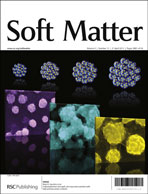Coalescence and compression in centrifuged emulsions studied with in situ optical microscopy†
Abstract
We report an experimental method to investigate droplet dynamics in centrifuged emulsions and its application to study droplet compression and coalescence. The experimental setup permits in situ monitoring of an ensemble of droplets in a centrifuged monolayer of monodisperse emulsion droplets using


 Please wait while we load your content...
Please wait while we load your content...